Snapdragon 800 (MSM8974) Performance Preview: Qualcomm Mobile Development Tablet Tested
by Brian Klug on June 18, 2013 8:00 PM EST3DMark
3DMark for Android features the Ice Storm benchmark and uses OpenGL ES 2.0. Ice Storm is divided into two graphics tests and a physics test. The first graphics test is geometry heavy while the second test is more pixel shader intensive. The physics test, as you might guess, is CPU bound and multithreaded. The overall score takes into account both graphics and physics tests. The benchmark is rendered to an offscreen buffer at 720p/1080p and then scaled up to the native resolution of the device being tested. This is a very similar approach we've seen by game developers to avoid rendering at native resolution on some of the ultra high resolution tablets. The beauty of 3DMark's approach here is the fact that all results are comparable, regardless of a device's native resolution. The downside is we don't get a good idea of how some of the ultra high resolution tablets would behave with these workloads running at their native (> 1080p) resolutions.
For these benchmarks we stuck with the default presets (720p, normal quality).
Here the key comparisons are against the Adreno 320 based HTC One/SGS4 (T-Mobile) and the PowerVR SGX 544MP3 based SGS4 (SHEVE300S). The Nexus 10 is interesting but pretty much a blowout. Snapdragon 800 is clearly the new high-end Android tablet SoC of choice.
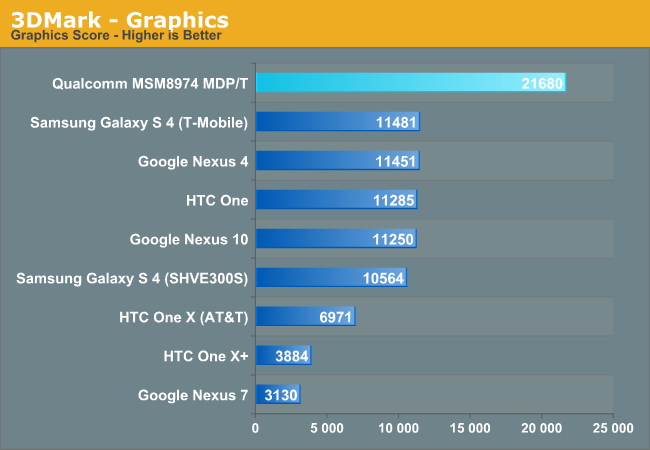
The overall graphics score from Adreno is amazing. We're looking at almost 2x the next fastest contender here, the Adreno 320 based Snapdragon 600.
Graphics Test 1
Ice Storm Graphics test 1 stresses the hardware’s ability to process lots of vertices while keeping the pixel load relatively light. Hardware on this level may have dedicated capacity for separate vertex and pixel processing. Stressing both capacities individually reveals the hardware’s limitations in both aspects.
In an average frame, 530,000 vertices are processed leading to 180,000 triangles rasterized either to the shadow map or to the screen. At the same time, 4.7 million pixels are processed per frame.
Pixel load is kept low by excluding expensive post processing steps, and by not rendering particle effects.

Graphics Test 2
Graphics test 2 stresses the hardware’s ability to process lots of pixels. It tests the ability to read textures, do per pixel computations and write to render targets.
On average, 12.6 million pixels are processed per frame. The additional pixel processing compared to Graphics test 1 comes from including particles and post processing effects such as bloom, streaks and motion blur.
In each frame, an average 75,000 vertices are processed. This number is considerably lower than in Graphics test 1 because shadows are not drawn and the processed geometry has a lower number of polygons.
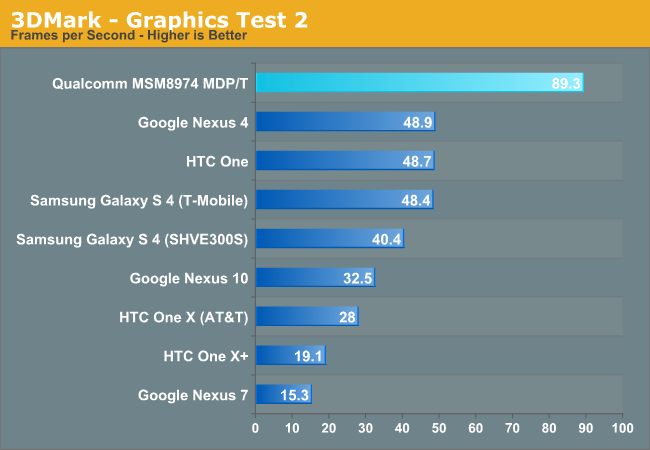
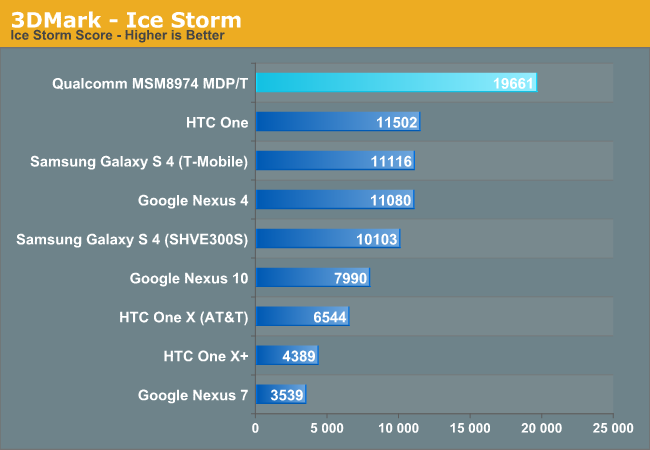
The overall Ice Storm score shows a 71% improvement over Snapdragon 600, which is the closest competitor.
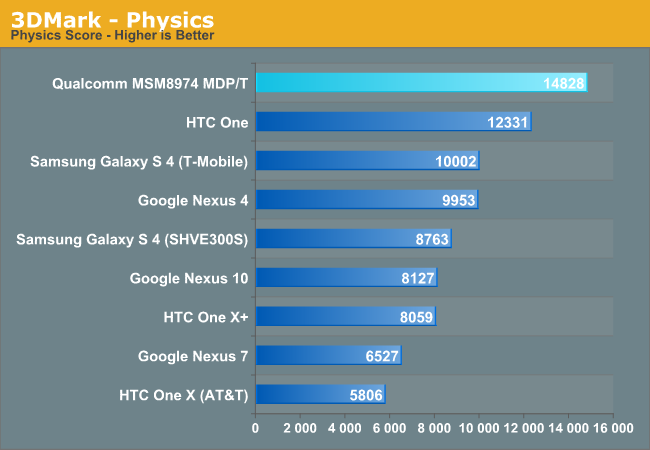
The physics test takes multicore CPU performance into account, but even then the Snapdragon 800 remains ahead of the pack. The performance advantage over the lower clocked Snapdragon 600 shrinks to just 20%, which is a bit lower than clock speeds alone would normally tell us.
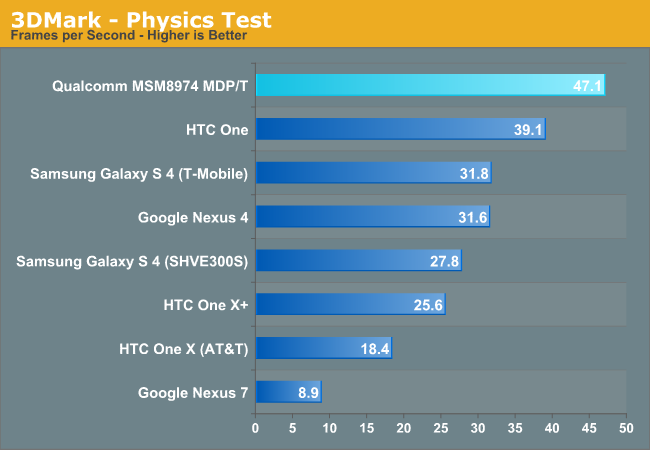










115 Comments
View All Comments
Krysto - Wednesday, June 19, 2013 - link
"The overall graphics score from Adreno is amazing. We're looking at almost 2x the next fastest contender here, the Adreno 320 based Snapdragon 600."Why is that so amazing? Adreno 320 came out first last fall, which is about a year before S800 with Adreno 330 comes out. Are you saying you're surprised mobile GPU's can double in performance every 12 months?
nunomoreira10 - Wednesday, June 19, 2013 - link
On the same process nod, hell yeahAenean144 - Wednesday, June 19, 2013 - link
Not exactly the same process node, and we don't know TDP yet.richworks - Tuesday, June 25, 2013 - link
please excuse my ignorance but how is TDP related to the process node?dishayu - Wednesday, June 19, 2013 - link
In the great equalizer charts, can someone please explain how GeForce 8500 manages to outperform the 7900 GTX in DXBenchmark 2.7? The 8500 had similar performance to a 7600GS from what i remember.nunomoreira10 - Wednesday, June 19, 2013 - link
Uniform shaders i believeRyan Smith - Wednesday, June 19, 2013 - link
Unified rather than uniform, but yes. We did an article in April looking at the issue in greater depth: http://www.anandtech.com/show/6877/the-great-equal...Speedfriend - Wednesday, June 19, 2013 - link
Where will the new generation Atom show up in the list? As I understand it, it will have graphics comparable to the HD4000 in the Ivy Bridge, so in theory it should outperform this Qualcomm chip?psychobriggsy - Wednesday, June 19, 2013 - link
No, it will have graphics based upon the HD4000 architecture - but it will have fewer units and run at a lower speed, in order to attain TDP requirements.FwFred - Wednesday, June 19, 2013 - link
The number of EUs does not directly tie to TDP. See HD5000 vs HD5100. The clock speed is important, and wider but slower is more efficient.